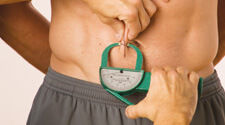Tools & Calculators
Percent Body Fat Calculator: Skinfold Method
Enter Skinfold Measurements in Millimeters
Your estimated Body Fat is:
Your estimated Lean Mass is:
Your estimated Fat Mass is:
Percent Body Fat Norms for Men and Women |
||
| Description | Women | Men |
| Essential Fat | 10-13% | 2-5% |
| Athletes | 14-20% | 6-13% |
| Fitness | 21-24% | 14-17% |
| Acceptable | 25-31% | 18-24% |
| Obesity | >32% | >25% |

|
||
Of the methods used to estimate body composition in clients, the skinfold measurement technique is probably the most commonly used by personal trainers. This technique is inexpensive, produces fairly accurate results (the standard error is 3.5%, depending on the equation applied, compared to 2.7% error for a hydrostatically determined measurement), and is relatively easy to administer once the trainer has mastered the skill of pinching the skin and measuring it with skinfold calipers.
Providing clients with an estimation of their body composition is a valuable practice because a person's level of body fat is directly correlated with health outcomes. Obesity-related diseases include heart disease, type 2 diabetes, hypertension, and stroke. Thus, helping clients work toward weight loss if they are overweight or obese can have a profound positive effect on their lives. The table below provides established percent body fat norms for men and women based on various categories of health and fitness.
Skinfold measurement is based on the belief that approximately 50% of total body fat lies under the skin, and involves measuring the thickness of the skinfolds at standardized sites. For results to be valid and reliable, the skinfold measurements must be taken properly and they should be taken by the same technician from one measurement to the next. Improper site determination and measurement are the two primary sources of error when using this method. Furthermore, skinfold measurements should not be taken after exercise because the transfer of fluid to the skin could result in overestimations.
The procedure for measuring skinfolds is as follows:
- Identify the anatomical location of the skinfold. Take all measurements on the right side of the body. (Optional: Mark the site with a common eyebrow pencil to expedite site relocation in repeated measures.)
- Grasp the skinfold firmly with the thumb and index finger of the left hand.
- Holding the calipers perpendicular to the site, place the pads of the calipers approximately 1?4 inch from the thumb and forefinger.
- Approximately one or two seconds after the trigger has been released, read the dial to the nearest 0.5 mm.
- A minimum of two measurements should be taken at each site, with at least 15 seconds between measurements to allow the fat to return to its normal thickness.
- Continue to take measurements until two measurements vary by less than 1 mm.
Calipers specifically designed for skinfold measurement are the only equipment needed for this method of body-fat assessment, and range in cost from $3 to $300. After the measurements are taken, the data are summed and applied to an equation to estimate body fat. Of the many equations for estimating body composition, two developed by Jackson and Pollock (1985) have the smallest margin of error for the general population. These equations are based on the sum of measurements taken at three sites. Since men and women differ in their patterns of storing body-fat, different anatomical sites are measured between the sexes.
For men, the skinfold sites are:
-
Chest: A diagonal skinfold taken midway on the anterior axillary line (crease of the underarm and the nipple)
-
Thigh: A vertical skinfold taken midway between the hip and knee joints on the front of the thigh
Abdomen: a vertical skinfold taken 1 inch lateral to the umbilicus
For women, the skinfold sites are:
- Triceps: A vertical fold on the back of the upper arm taken halfway between the acromion (shoulder) and olecranon (elbow) processes
- Thigh: A vertical skinfold taken midway between the hip and knee joints on the front of the thigh
- Suprailium: A diagonal fold taken at, or just anterior to, the crest of the ilium
Fat Mass and Lean Mass Calculator
After obtaining a client's body fat percentage, it is often helpful to calculate his or her body composition in terms of fat weight and lean weight. This is crucial for re-assessment when you want to compare the loss of fat and the maintenance or gain of lean weight to the client's original baseline values.
Ideal/Optimum Weight Calculator
After determining a client's body composition in terms of fat weight and lean weight, you can help him or her set a realistic goal for desired body weight. Initial goal setting should be focused on small attainable objectives, such as losing 10% body weight or moving from one body fat classification category to the next. Since lean mass can increase as a response to exercise, regular body composition assessment can help clarify if increases in body weight are a result of enhanced muscle or actual body fat. It is important to understand that muscle weight can increase even when exercise participation is limited to aerobic activity. Body composition should be assessed periodically throughout an exercise program. This can provide motivating information, especially when fat weight loss appears to have plateaued.
Share:
Get in the Know
Stay connected with us to get the latest health and fitness news, innovative workouts, healthy recipes and wellness tips.